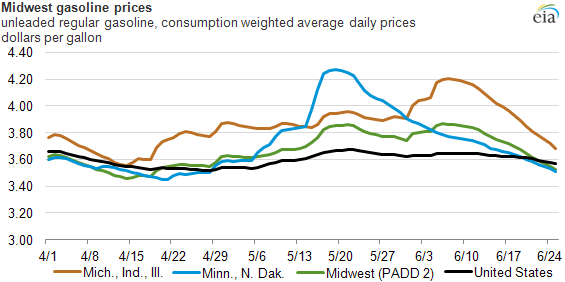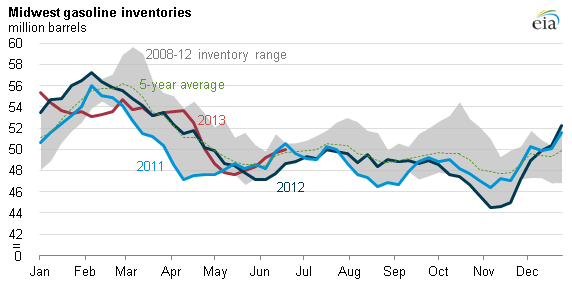
Midwest gasoline prices returning to normal

As previously reported, Midwest gasoline prices shot up in April and May with refinery outages—some planned, some not—that lasted longer than expected, thus reducing Midwest gasoline supply. But Midwest gasoline prices are now falling closer to normal, helped by resumption of refining and the import of gasoline from other parts of the nation.
Fuel prices in Minnesota and North Dakota have fallen to below the current U.S. average gasoline price, and prices in Michigan, Indiana, and Illinois are heading lower with the return of regional refinery production.
Since April, nationwide gasoline prices have been stable, moving within a 16-cents-per-gallon range. But Midwest (PADD 2) prices varied in a range almost three times that of U.S. average prices.
Planned and unplanned refinery maintenance as well as longer-term refinery upgrading projects over the past few months reduced gasoline production in the Midwest, pushing gasoline inventories lower and gasoline prices higher. Refinery utilization in the Midwest averaged 85% over the four weeks ending June 21.

Gasoline inventories typically increase before refinery maintenance season, and in April gasoline inventories were high. However the number of unplanned refinery outages—including Flint Hills (277,000 bbl/d) in Minnesota and Holly Frontier (138,000 bbl/d) in Kansas—and longer-than-anticipated planned maintenance caused gasoline inventories to decline quickly. Between mid-April and mid-May, Midwest gasoline inventories declined by 6 million barrels (11%) before recovering as refineries returned to normal operations and as gasoline supplied from other regions reached the Midwest.
Refineries in the Midwest do not typically produce enough gasoline to meet Midwest demand, especially during the summer driving season. As a result, gasoline is supplied to the Midwest by pipeline and barge from other regions of the country, mostly from the U.S. Gulf Coast. Given the distances involved, resupply times can be long, which amplifies price volatility during disruptions.
Prices in Minnesota and North Dakota have come down sharply following the resumption of operations at Minnesota's two refineries, Northern Tier and Flint Hills. In the Great Lakes region, the 239,000 bbl/d Joliet, Illinois, refinery, which had been shut down for planned maintenance and which was expected to restart around the end of May, returned to operation on June 10, according to trade press reports, while BP's Whiting, Indiana refinery is expected to restart a crude unit that has been out of service since late last year by the end of June. While it will take several weeks for the refineries to reach full production, resupply from the U.S. Gulf Coast is already reaching the Midwest via pipeline.
For more information about Midwest gasoline prices, see the May 23 edition of This Week in Petroleum.
Tags: disruption, gasoline, liquid fuels, Midwest, oil/petroleum, prices, refining, states